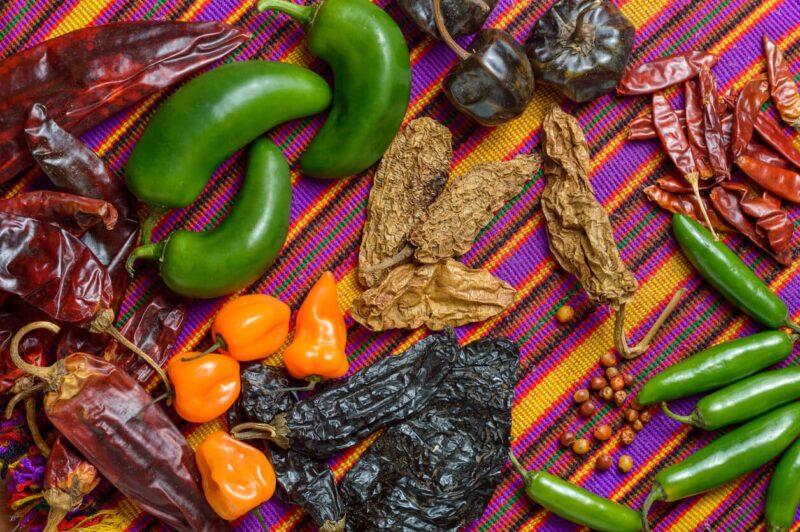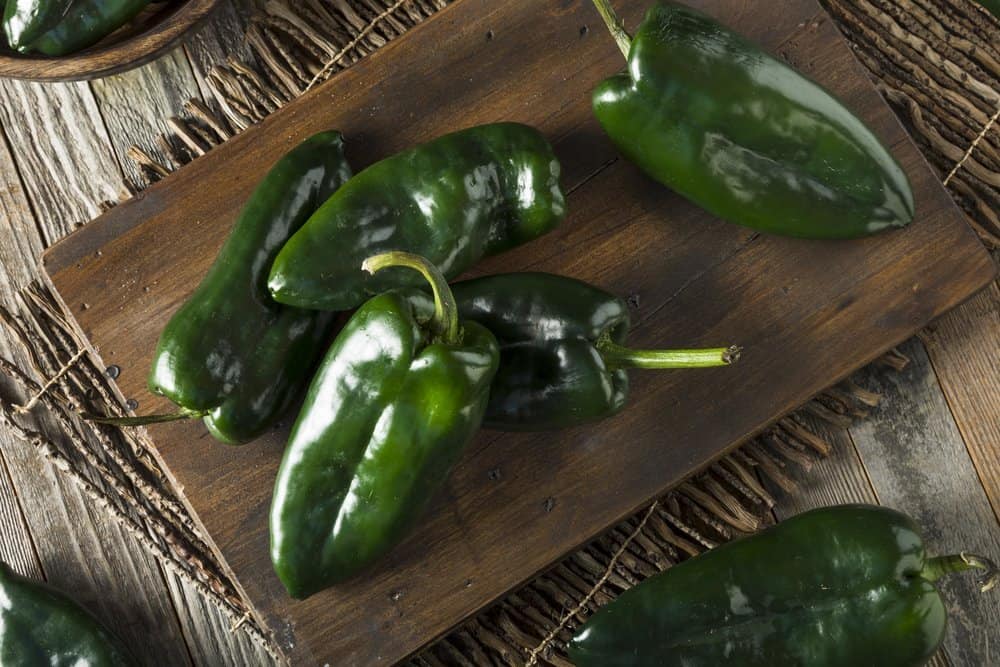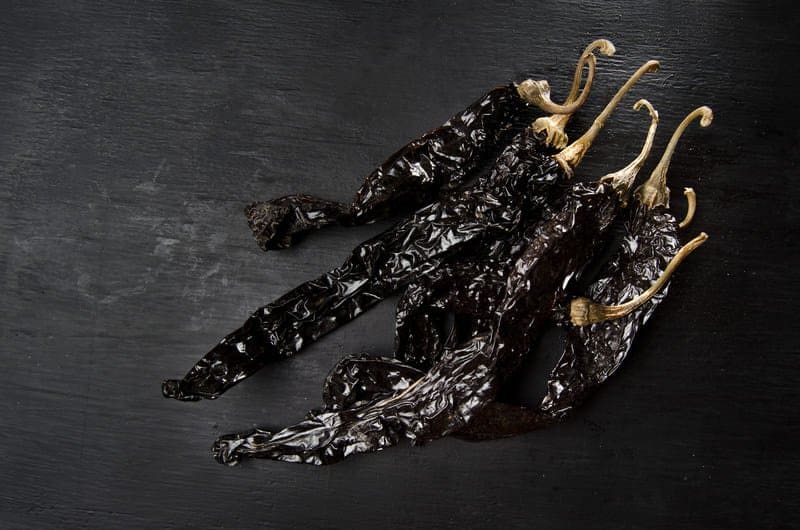Many spices in our world have a unique taste and offer a spectacular flavor to any dish.
Two of such spices include poblano and pasilla, found in sauces, salsas, and multiple other cuisines! Aside from their uses, though, these two peppers may look very similar but have some differences.
So, what is the difference between poblano and pasilla? The pasilla is a thin dried chili, but the poblano is a fresh chili roughly the size of bell pepper.
In this article, we’ll talk more about the differences between poblano and pasilla. Read on!
What is Poblano?
The poblano pepper is a famous Mexican chili pepper with dark green skin that ripens to a rich red or brown hue. They are gentle, big, and heart-shaped.
The pods are usually 4 inches long with a dark green tint, maturing to a dark red or brown color. Farmers typically harvest them when they are green for general cooking.
Poblanos are mild peppers that are quite large and slightly heart-shaped. Their skins/walls are thick, making them ideal for stuffing because they will hold up well in the oven.
When cooking with Poblano, they are frequently roasted and peeled or dried. They are known as ancho chilis when dried.
Poblanos are indigenous to Puebla, Mexico and they are one of the most widely cultivated peppers there. The plant has many stems and can grow to be up to 25 inches tall. The pods can reach a length of 3-6 inches and a width of 2-3 inches.
What is Pasilla?
Pasilla (chile pasilla) or ‘little raisin’ is the dried chilaca pepper, a famous Mexican chili pepper. When fresh, the chilaca pepper is also known as pasilla bajio, chile negro, or ‘Mexican negro,’ since it begins dark green and ends dark brown.
It usually develops to be 8-10 inches long.
People use pasilla peppers in Mexican cuisine and cooking, notably preparing sauces such as moles, table sauces, and salsas. They also crush the peppers into a powder for use in similar applications or as spices.
The ‘chili pasilla,’ together with ancho and guajillo peppers, is frequently referred to as the holy trinity of Mexican chile peppers.
Poblano vs Pasilla: Comparison Table
The table below denotes the major differences between both poblano and pasilla peppers.
| Category | Poblano | Pasilla |
| Appearance | 4-inch long and dark red/brown | 10-inch long and dark brown in color |
| Hotness Level | 1000-2000 | 1000-2500 |
| Taste | Earthy and similar to
Green pepper |
Smokey and Fruity as dried berries |
| Availability | Fresh poblano is more readily available | Fresh pasilla is hard to find but dried one is available |
Poblano vs Pasilla: What’s the Difference?
Poblano and pasilla have several differences between them. We have covered the main ones as mentioned below:
Taste
Poblanos are offered green and unripe, which makes them exceptionally mild. They have a flavor comparable to a green bell pepper but with a bit more zing.
Cooking poblanos soften them even more and turn them slightly sweet.
On the other hand, pasillas have a smokey, fruity, earthy flavor that people often compare to berries and dried fruits (like raisins).
These peppers have a taste comparable to ancho chiles, although they are less sweet.
Hotness
Poblano peppers are mild chili peppers. They range from 1,000-2,000 on the Scoville scale, which measures chiles’ heat level.
On the other hand, Pasilla peppers have a moderate heat. They range from 1,000-2,500 on the Scoville scale.
Appearance
You can easily make out the difference between poblano and pasilla due to the variation in their appearances.
For instance, you will find that poblano peppers are somewhat heart-shaped and 4 inches long. On the other hand, pasilla peppers are elongated as they’re about 8-10 inches long.
Additionally, there’s also a slight color variation as poblano peppers become dark red or brown when they mature, whereas pasilla peppers may turn dark brown.
Usage
Both poblano and pasilla peppers may have different uses. Let’s take a closer look at the most common ones below.
Poblano Peppers:
- Dressing: Make a buttermilk dressing with the roasted chiles for spreading over tomatoes or crisp lettuce.
- Guacamole: You can add a subtle kick of spice by adding roasted poblanos into the classic avocado dip.
- Relish: Poblano chilies and maize are a tried-and-true combination. Use them to make relish to serve with fish.
- Pesto: For a Mexican take on an Italian sauce, combine roasted poblanos with garlic, cilantro, and feta.
- Stuffed: Poblanos are excellent stuffing peppers, providing just a hint of spice to a filling meal, whether packed with meat, quinoa, or veggies.
- Corn Bread: Instead of the traditional jalapeno, smear this darker, milder chili on your cornbread.
- Posole: Chili may be made using hominy (big, creamy maize kernels) and poblanos for a fiery bite.
- Cocktails: Muddle poblanos in your margarita or prepare the Poblano Escobar, a pineapple-tequila cocktail.
- Soup: For any blended green vegetable soup, sauté the chiles with the aromatics. They’re delicious with mild zucchini.
Pasilla Peppers:
- Sauces, moles, and soups: You can use pasilla peppers to add a unique heat to any type of sauce or soup. Typically, you can make a puree and add it to the soup. Or you can add dried pasilla flakes to the food.
- Chili Flakes: To add a spicy yet fruit flavor to any dish, you can use dried pasilla flakes as chili flakes. But, keep in mind that they won’t give the generic spiciness.
Note that pasilla chilies, like other dried peppers, are extremely rough on their own. Therefore, they are usually pureed or somehow integrated into the meal.
So, you won’t find anyone softening these chilies and filling them up because of their long and thin form, unlike their ancho relatives.
Availability
You can find both poblano and pasilla in the supermarket. However, it’s a lot easier to find fresh poblano, whereas pasilla is more readily available in dried form.
Related Questions
Can I substitute Pasilla for Poblano?
No, as a fresh pepper, pasilla is not a substitute for the smokey, earthy, and dried pasilla or vice versa. However, you can use pasillas and anchos in place of one another.
This is because the flavor profiles of the dried chiles are similar enough that many people won’t be able to identify the difference after they’re used in a dish.
On the other hand, Anaheim pepper is the most acceptable replacement for poblano.
The Anaheim pepper is a bit more intense (twice as intense as a poblano). However, this chili is a great alternative for poblano pepper.
What is another name for a Poblano pepper?
Capsicum Annum is another name for poblano pepper. When dried, it is also known as ancho or chile ancho.
What pepper is most similar to Poblano?
There are so many peppers that are similar to poblano.
The most similar pepper to Poblano pepper is Anaheim pepper. Other substitutes include Bell Pepper, Jalapeños, Cubanelle Peppers, New Mexico Chilies, etc.
What kind of pepper is Pasilla?
The dried form of chilaca pepper is pasilla pepper.
This pepper changes its color from dark green to dark brown and can grow over six inches long. Some people also know it by the name of chile negro or pasilla negro chiles.




